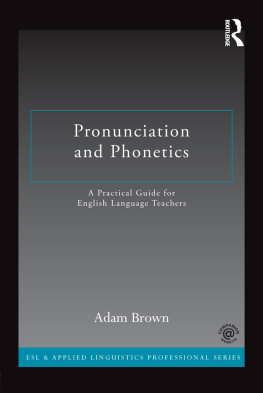
Clear English Pronunciation
Clear English Pronunciation
provides students with the tools to effectively com-
municate in English without centring solely on native-speaker pronunciation
models. The focus of the book is on individual pronunciation targets rather than
a one-size-ts-all approach. Divided into four sections, each featuring detailed
articulatory explanations, sample sentences, and recordings to help learners
improve their pronunciation, this book:
introduces the phenomenon of pronunciation as part of a broader communi
-
cative realm;
explains and demonstrates the melody and rhythm of understandable and
natural English pronunciation;
supports students in identifying and practising their own pronunciation
issues.
Supported by an interactive companion website which features recordings and
expanded explanations of key topics,
Clear English Pronunciation
is an essential
textbook for international learners of English who want to improve their pronun-
ciation skills in diverse social settings.
Dick Smakman
is a Lecturer at Leiden University, the Netherlands. He teaches
and researches English language acquisition and sociolinguistics. He has taught
English, Dutch, and sociolinguistics at various universities.

Clear English Pronunciation
A Practical Guide
Dick Smakman
First published 2020
by Routledge
2 Park Square, Milton Park, Abingdon, Oxon OX14 4RN
and by Routledge
52 Vanderbilt Avenue, New York, NY 10017
Routledge is an imprint of the Taylor & Francis Group, an informa business
2020 Dick Smakman
The right of Dick Smakman to be identified as author of this work
has been asserted by him in accordance with sections 77 and 78
of the Copyright, Designs and Patents Act 1988.
All rights reserved. No part of this book may be reprinted or
reproduced or utilised in any form or by any electronic,
mechanical, or other means, now known or hereafter invented,
including photocopying and recording, or in any information
storage or retrieval system, without permission in writing from
the publishers.
Trademark notice
: Product or corporate names may be trademarks
or registered trademarks, and are used only for identification and
explanation without intent to infringe.
British Library Cataloguing-in-Publication Data
A catalogue record for this book is available from the British Library
Library of Congress Cataloging-
in-Publication Data
Names: Smakman, Dick, Library of Congress Cataloging-in-
Publication Data
Names: Smakman, Dick, 1970- author.
Title: Clear English pronunciation : an introduction / Dick
Smakman.
Description: New York : Taylor and Francis, 2020. | Includes
bibliographical references and index. |
Identifiers: LCCN 2019035220 (print) | LCCN 2019035221
(ebook) |
Subjects: LCSH: English language-Pronunciation. | English
language-Pronunciation by foreign speakers. | English language-
Phonology. | English language-Spoken English.
Classification: LCC PE1137 .S497 2020 (print) | LCC PE1137
(ebook) | DDC 428.1/3-dc23
LC record available at https://lccn.loc.gov/2019035220
LC ebook record available at https://lccn.loc.gov/2019035221
ISBN: 978-0-367-36644-5 (hbk)
ISBN: 978-0-367-36643-8 (pbk)
ISBN: 978-0-429-34738-2 (ebk)
Typeset in Times New Roman
by Wearset Ltd, Boldon, Tyne and Wear
Pronunciation
For several reasons, pronunciation is an atypical aspect of language learning. It
distinguishes learners on the basis of skills other than the academic. First of all,
it involves control over many tiny muscles in the speech tract, and is in that
respect more practical and physiological than other linguistic skills. It is also
different because it is an uncomfortable skill to some. Second-language pronun-
ciation often involves imitating both the pronunciation and subtle communica-
tive habits of real or prototypical speakers. This act of imitation may feel a little
unnatural. Another reason for the special role of pronunciation is its function as
personality marker. Listeners will make judgements on the basis of pronuncia-
tion skills; a speakers image, professionalism, and even personality and intelli
-
gence are gauged through their pronunciation in particular.
The term pronunciation as referred to above is used in a broad sense. It
refers not only to the way the mouth is shaped during the production of conso-
nants and vowels, but also to a system of stress and intonation, and to general
articulation habits. Bourdieu (1991) emphasised that while individual sounds are
often studied in isolation, and subsequently compared with equivalents in other
peoples speech, they are only a part of a larger pronunciation style in which all
individual articulation features (consonants and vowels, but also intonation and
general vocal-tract usage) should be studied as an indivisible totality (86).
Together, these form your pronunciation, and this skill thus entails a broad
behavioural pattern.
Because of the intrinsic complexity of pronunciation, the outcome of a pro
-
nunciation course is harder to control or predict than the outcome of courses on
other aspects of language acquisition; most notably, grammar and vocabulary.
While a specic grammatical construction or word choice is often simply correct
or incorrect, successes in pronunciation are often difcult to measure objec
-
tively. Different people will all perceive and evaluate a certain pronunciation (its
understandability, its beauty, its correctness, etc.) in their own way (Hoorn,
Smakman, & Foster, 2014). Whether someones pronunciation is good




















